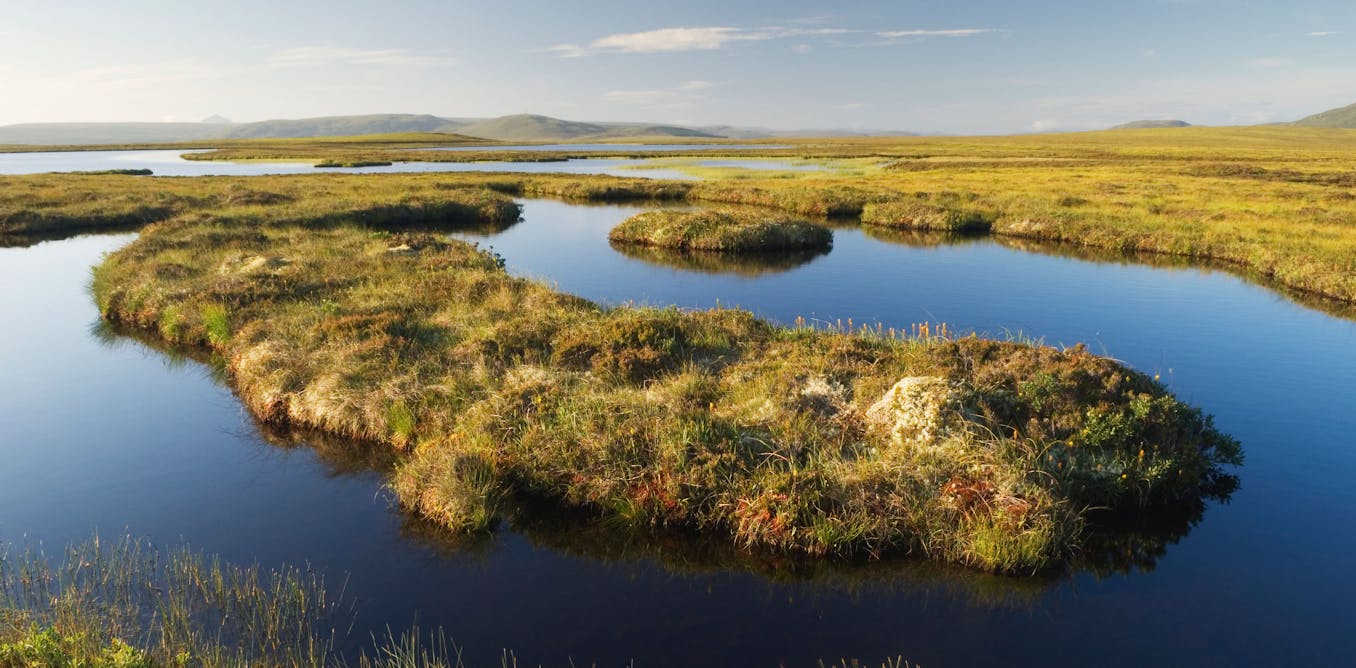But peatlands across the world have been hugely damaged by human activities such as drainage, agriculture and peat cutting. The recent COP27 conference saw the launch of a UN’s Environment Programme Global Peatlands Initiative assessment. This initiative draws attention to the loss and damage of peatlands, and the importance of rehabilitation and restoration in tackling global warming and the biodiversity crisis.
Peatlands are also important for culture and heritage, preserving sites and artefacts threatened by climate change if these wetlands continue to dry out and degrade. Recent excavation and analyses at the Mesolithic peatland site of Agerod in Sweden has demonstrated significant deterioration of important archaeological remains over the last 75 years.
These scientific developments and renewed focus have brought bogs into closer contact with other disciplines and in particular, artistic endeavour, from poetry and prose to music and film.
Peatlands and culture
The place of peatlands in our cultural consciousness is hardly new: think of Sherlock Holmes and Dartmoor’s treacherous Great Grimpen mire in The Hound of the Baskervilles, or the sinister Dead Marshes in Tolkien’s The Lord of the Rings.
In fact, once this fluid connection is recognised, peatlands emerge as a potent and unexpected metaphor in the work of perhaps less obvious authors such as Edna O’Brien, in whose work the bog is a place of danger, dark and forbidding. A range of visual artists have also painted, drawn or employed the imagery of peatlands in various ways.
Less traditional ways of engaging with peatlands are to be found in a new generation of writers, poets, musicians and filmmakers. Visual artist Nigel Rolfe produced a video piece entitled Into the Mire, showing the artist falling face first into the flooded peat cuttings of an Irish bog. He describes the action as: “Framing the ‘backyard bog’ of Ireland in terms of the country’s Euro-economic relations, current poverty crisis and the impending failures of the geopolitical landscape” – quite literally a slump into the economic mire.
The transformative power of the bog, its uncanny ability to preserve but also alter substances brought into contact with its acidic waters, is a theme favoured by the Scottish composer Erland Cooper. In his 2021 composition Carve The Runes Then Be Content With Silence, he imaginatively commemorated the centenary of Oracdian poet George Mackay Brown.
Cooper left a series of clues to allow musical treasure seekers to track down the ¼-inch magnetic master tape of his piece, which he had buried in peaty soil on Orkney. The acidic waters of the peat would affect the ferrous tape, leading to degradation of the recording. This artistic act thus cast the peatland as a non-human co-composer.
The tape was found earlier this year and will journey to the Barbican, London, where the piece will be performed in the form “exactly as it sounds from the earth”.
Preservation and memory
Ian Dagnall / Alamy
This ability of peatlands to preserve things, partially at least, buried or submerged and left behind for perhaps more sinister reasons, is a point of inspiration for some artists.
Artist, writer and academic Jools Gilson’s recent piece Tempestries is based around the Medieval Irish “bog body” the Cloonshannagh Woman, an archaeological find notable for the preservation of fragments of textiles representing the remains of the dead woman’s clothing. Bog bodies also continue to attract a large amount of media attention, further bringing dark archaeological finds into contact with the wider public.
The bog has long played a role in literature, especially poetry. The link between Seamus Heaney and peatlands is enduring; probably the best known in this context are the “bog poems” such as The Tollund Man, which draws on the famous Danish bog body of the same name:
She tightened her torc on him
And opened her fen,
Those dark juices working
Him to a saint’s kept body
But new poets have been influenced by these environments in different ways. Donegal poet Annemarie Ní Churreáin’s 2017 collection Bloodroot includes the wonderful poem Bog Medicine. This piece weaves themes of the tension between traditional and ancient beliefs and identity into the (peaty) landscape: an appeal to the “pagan hill” which “… will answer in bog tongue”.
Other recent work has considered the bog as a metaphor; Derek Gladwin writes in his book Contentious Terrains of the way that certain works of Irish literature from the late 19th century use the “… destabilising and haunting capacities of the bog provide a space to explore historically fraught colonial tensions and social struggles through the Gothic form”. This can be seen in Bram Stoker’s The Snake’s Pass, which which revolves in part around a mysterious bog and engages with questions of who has rights to the land in an Ireland under British rule.
One practical aspect of recent artistic flowering is the way in which exploring the idea of the bog can open up conversations and discussions concerning the biodiversity crisis and the importance of peatlands and other wetlands, in cultural as well as environmental terms.
The restoration of peatlands is not just a process that will protect or enhance ecological functions, but one that should ensure the bog survives and maintains its place in society and culture across northwest Europe as well as globally.
Ecosystems are never static of course, and ecological rehabilitation cannot wind back damaged environments to previous, pristine states. However, dynamism and change are also central to the human condition and the artist’s task might be in part at least, to help us come to terms with this and to encourage us to confront the global climate crisis.

Don’t have time to read about climate change as much as you’d like?
Get a weekly roundup in your inbox instead. Every Wednesday, The Conversation’s environment editor writes Imagine, a short email that goes a little deeper into just one climate issue. Join the 10,000+ readers who’ve subscribed so far.




















